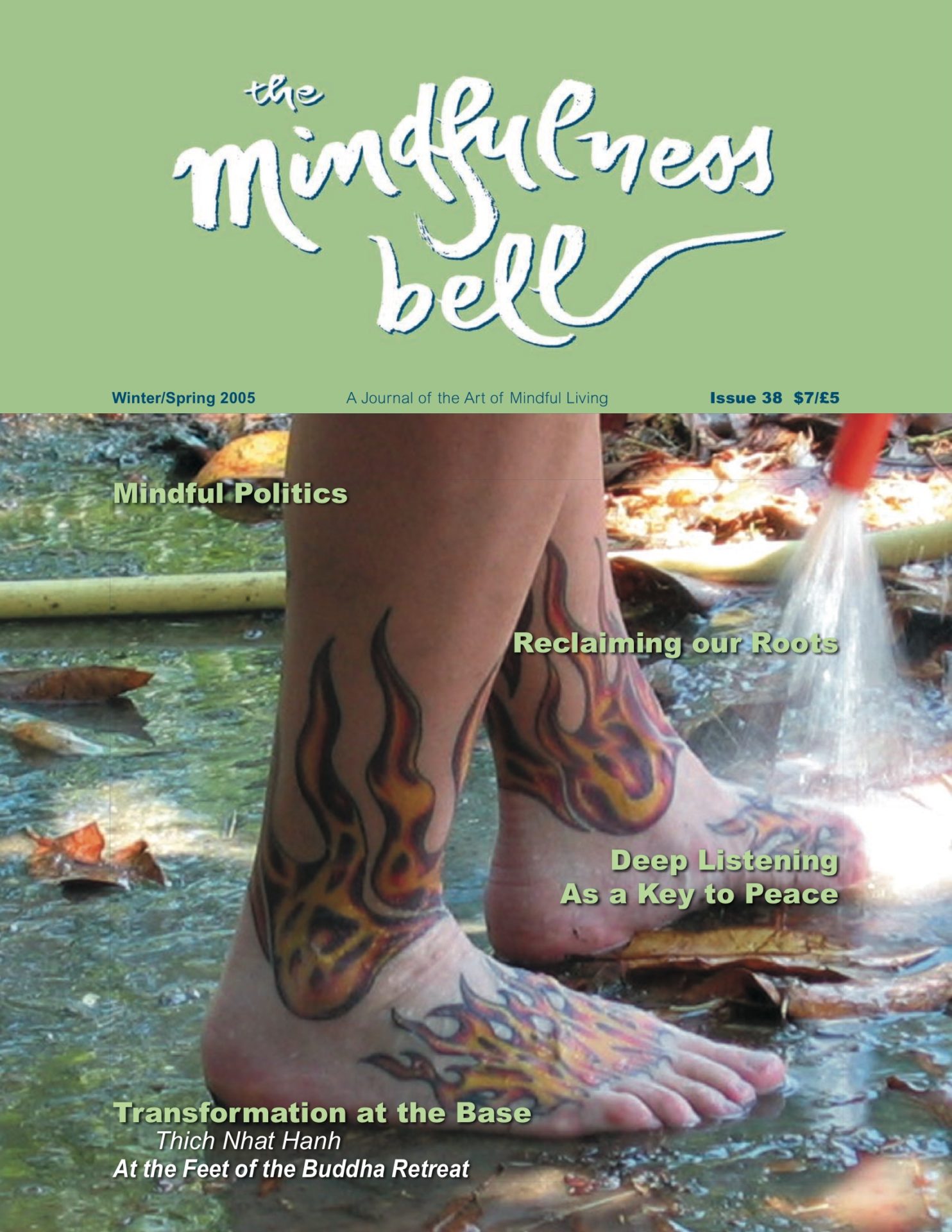From talks given June 11 and June 14, 2004, at The Feet of the Buddha Retreat, Plum Village
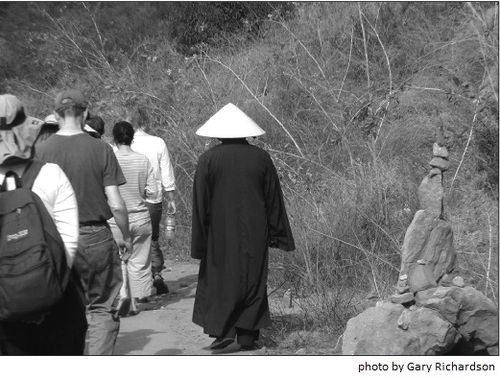
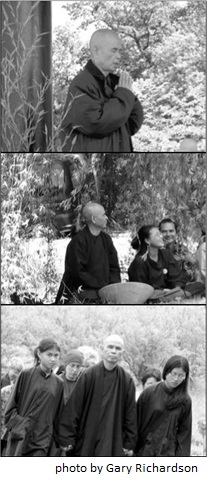
In June, 2004, Thich Nhat Hanh offered teachings on the nature of consciousness at The Feet of the Buddha Retreat in Plum Village. Expounding on the material published in Transformation at the Base, Fifty Verses on the Nature of Consciousness (Parallax Press,
From talks given June 11 and June 14, 2004, at The Feet of the Buddha Retreat, Plum Village


In June, 2004, Thich Nhat Hanh offered teachings on the nature of consciousness at The Feet of the Buddha Retreat in Plum Village. Expounding on the material published in Transformation at the Base, Fifty Verses on the Nature of Consciousness (Parallax Press, 2001) Thay offered methods of practice that will deepen our understanding of ourselves and of reality.
Here, Thay speaks about the practice of visualization, explaining how it can enhance our mindfulness through such diverse examples as recent information from nuclear science and a marvelous story about the mother of the Buddha.
Also included in this section is Learning to Speak the Truth, an excerpt of a talk given at the same retreat by senior student and Dharma teacher, Thay Phap An, who shares stories of some of his difficulties as a young monk in the early days at Plum Village.
The practice of visualization is very important in Buddhism, but practitioners of other disciplines need imagination and visualization too. In order to learn, in order to create, we need the capacity to imagine and to visualize. For example, studying mathematics takes a lot of visualization. If your power of visualization is weak you cannot learn a kind of mathematics called projective geometry. If you are an architect, you have to visualize in order to create new forms of architecture. Many scientists have to visualize a lot, because they have to see molecules and atoms with their mind, since they cannot see them with their eyes. Theories concerning the elementary particles of the cosmos come from visualization.
While scientists use instruments and tools to empower their vision, practitioners use visualization to purify their minds so they can look deeply at the nature of reality.
Visualization While Walking
Using the techniques of visualization during walking meditation can bring us love, wisdom, and joy. When we study the levels of consciousness, we see that the sixth––mind consciousness, also called the gardener––has the power to imagine, to visualize.
When you make a step, you might visualize that your mother is taking the step with you. This is not difficult to do, since you know that your feet are a continuation of the feet of your mother. As we practice looking deeply, we see the presence of our mother in every cell of our body. Our body is a continuation of our mother’s body. When you make a step you might say, “Mother, walk with me,” and suddenly you feel your mother walking with you. Perhaps during her lifetime she did not have a chance to walk in the here and the now, and to enjoy touching the earth like you have. So, suddenly compassion is born in you, because you can see your mother walking with you. Not in your imagination, but as a reality. You can invite your father and other people you love to walk with you, and you feel they are present in the here and the now. You don’t have to be with them physically in order to touch their presence.
If we know that all our ancestors are fully present in every cell of our body, then when we make a step, we know that they are all taking that step with us. Your mind can see the feet of all your ancestors, millions of feet, making a step with you. Using visualization in that way will shatter the idea that you are a separate self. You walk, and they walk too.
Our Perceptions are Mental Constructions
There are many incorrect things on the screen of our consciousness, and if we know how to focus we can erase them. We bring our wisdom to that view of illusion projected on our screen, and we recognize it as an illusion. Then we press on the mouse, and it is erased from our screen.
When illusion is erased, something appears. The disappearance of ignorance (avidiya) helps the light, the wisdom to arise. So when you use your mind to erase the illusion, the truth appears. Thanks to our practice of looking deeply, we know that what appears in our consciousness is the collective construction of our mind. With practice, we are no longer sure of our perceptions. We become more careful. We know that what is perceived is very much the collective construction of our consciousness.
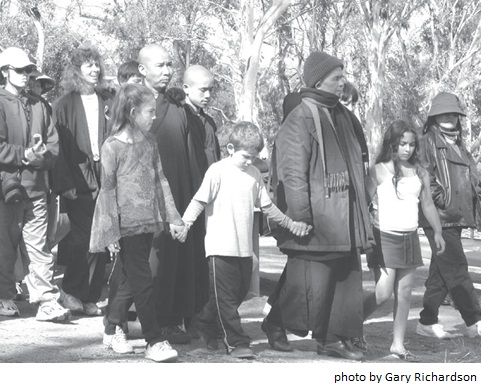
Parakalpita means collective mental construction. In the past, when we did not practice, we believed that the world of mental construction is a solid, objective world. But now as we begin to practice, we learn that what we touch, what we see, what we hear, is only a collective mental construction. We begin to understand that what we perceive is very much the construct of our consciousness. To recognize parakalpita as a mental construction is a step toward wisdom. And our practice will help us to see that the nature of the world as we see it is the nature of parakalpita, the nature of mental construction.
So with the practice of mindfulness you become more alert. Anything you hear, you touch, you see––you know that it has the nature of mental construction, and you do not consider it as reality. The world of representations may carry some substance of the world, of things in itself, but it mostly consists of representations. And it is collective in nature; for example, the person sitting next to you will see and hear almost the same things that you see and hear. Because you are made similarly, you perceive in the same way.
The Process of Seeing and Hearing
We know that the images we see are projected onto our retina, and our brain translates them into electrical impulses, which forward them to the center of sensation in the occipital lobe. We don’t see with our eyes; our eyes only receive images which are translated into the language of electrical signals. And an image does not come as a whole; it comes as millions of dots, received and processed by more than thirty different regions of the cortex.
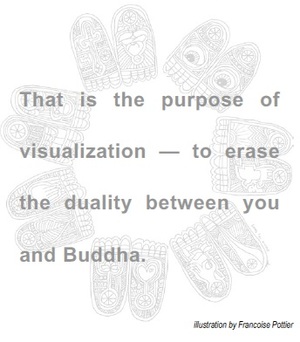
The same happens with sounds. A sound is received and translated into electrical signals, then goes to an area just below the occipital lobe, and then is transferred to many areas of the cortex, and finally sent to the parietal lobe. Then we become aware of it.
Whether it is sound or image or touch or smell, all are translated into electrical signals so that the mind can receive and process. It is very, very complicated. That is why the teacher Vasubandhu said that the processing of store consciousness is not something that mind consciousness can access. And that is why we agree with what the Buddha said in the Diamond Sutra: All conditioned dharmas are like a dream, are like magical performances, are like water bubbles, are like reflected images, are like a drop of dew, are like lightning. The Buddha said, “Dear one, you have to train to look at them like that.”
Because of what we know, we don’t believe that what we perceive is objective reality. It is the mental construction of our consciousness, and we know that is the nature of our perceptions. What we conceive to be personalities, people, atman––what we conceive to be entities, dharmas––are just mental constructions. They are evolving in many ways, but they are all manifestations from consciousness. That is the first verse of The Thirty Verses on consciousness, offered by Vasubandhu.
Touching Interbeing
Knowing that we live in the world of parakalpita, we should practice looking deeply in order to discover the nature of interbeing, because if we look deeply into the world of mental construction, we can touch the nature of interbeing, the nature of paratantra. Paratantra means “leaning on each other,” depending on each other in order to manifest. You cannot be by yourself. You have to inter-be with everything else.
For example, a flower has to rely on many non-flower elements in order to manifest. That is why when we look at a flower we don’t see a separate entity. If we see a flower as an entity, then we are still in the parakalpita world. And when we see another person as an atman, a separate self, then we are still in the world of parakalpita. That is why using mind consciousness, we are not focused on these so-called selves and dharmas in order to discover the nature of paratantra. Empty inside, empty as a self, empty as an entity: for that you need the energy of mindfulness and concentration. You live your day mindfully. You look deeply at anything you come in touch with, and you are not fooled by appearance. You are not caught in a world of parakalpita; you are capable of seeing that those you meet are devoid of any solid entity, any solid selves.
Looking into the son, you see the father and the mother and the ancestors; you see the son is not a separate entity. Looking into yourself––your suffering, your happiness––you don’t see you as a separate self, you see a continuation. This is to learn how to see everything in the light of interdependence, interbeing. Everything is based on everything else in order to manifest. Slowly the notion of one and of many vanish.
Training to See the True Nature of Reality
The nuclear scientist David Bohm practiced looking deeply, and he said that an electron is not a separate entity; one electron is made of all the other electrons. He seemed to understand that the one is made of the all, and just touching the one deeply, you touch everything.
So touching the nature of paratantra, we understand that there are no separate entities. There are only manifestations that rely on each other to be possible, like the left and the right. The right is not an entity that can be by itself. Without the left, the right cannot be. Everything is like that.
The first verse of Vasubandhu’s thirty verses is that the metaphor of selves and dharmas are evolving in several ways. They are creations of consciousness, mental creations. The sixth, the seventh, and the eighth levels of consciousness create.
The Buddha offered us the insight of impermanence and the insight of no-self, as tools for us to touch the world of parakalpita so that we can discover the nature of interbeing, the nature of interdependence, which is devoid of any solid, separate self. One day the Buddha told his beloved disciple, Ananda: “Whoever sees interbeing, that person sees the Buddha.” If we touch the nature of interdependence, of interbeing, we touch the truth, we touch wisdom. We touch the Buddha.
During the day, while walking or sitting, eating or cleaning, you dwell in the concentration of paratantra, so that you can see things as they are, not as selves, not as entities, but as mental constructions that rely on each other in order to manifest. This is the process of training. And finally, when the training is complete, the nature of parinispanna will appear, will reveal itself entirely, and what you touch is no longer a world of illusion, but the world of thing-in-itself. These are the principles of the practice.
First of all, we should be aware that the world in which we live is being constructed by us, by our mind, collectively. That if we look deeply, if we know how to use mindfulness and concentration, we can begin to touch the nature of interdependence. And when our practice is deep, we can erase the illusion of parakalpita so the true nature of reality can be revealed: the nature of parinispanna.
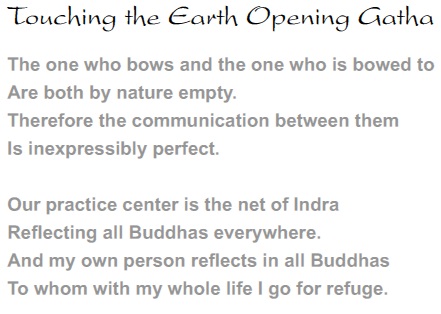
Visualizing Before Touching the Earth
Visualization can be very helpful. When I was a young novice in Asia, this practice was taught to us, but most of us could not do it. We memorized very well, we chanted very beautifully, but we could not do this visualization for the first ten or fifteen years. The moment you can do it, you feel wonderful. You can erase the notion of self through this practice.
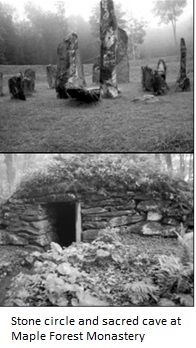
If you are an intelligent practitioner, you do not touch the Earth with the intention of begging the Buddha to give you something, or to forgive you for having done something. That practice is still based on the notion of separate selves: the belief that you and the Buddha are different; that you are almost nothing, and the Buddha is everything; that you need him to give you a little bit of wisdom or happiness. With that kind of intention, you still live in the world of parakalpita. So before touching the Earth before the Buddha, you have to visualize that you are empty of a separate self, and also that the Buddha is empty of a self. The one who bows and the one who is bowed to are both by nature empty. It’s difficult to find another tradition with a similar practice. For instance, you cannot stand in front of the deity you worship, and say, “You, my God, you are empty!”
Before you bow, you say something like this: “Dear Buddha, I am bowing to you, but I know deeply that I am empty and you are also empty, because you are in me and I am in you. When I am touching the Earth before you, it may look ridiculous. But looking deeply, I see that I bow like this in order to touch you in me, and so that you can touch me in you also.
Then you visualize countless Buddhas appearing, like the image of Indra’s net. This is a net made of jewels, and in each jewel you see reflected all the other jewels. Looking into the one you see the all. Suppose you build a hall made of mirrors, and then you enter holding a candle. Looking into a mirror you see you and the candle, and when you turn around you see that each mirror reflects you and the candle in the mirror too. You just need to look into one mirror to see all the reflections of you and the candle. Countless yous and countless candles are reflected in just one mirror.
So you are standing there, about to touch the Earth and get in touch with the Buddha. And you have to visualize countless Buddhas appearing around you, and in front of each Buddha there is one you who is touching the Earth. You touch the Earth in such a way that the barrier between you and Buddha is no longer there. You use the tool of your mind to erase the distinction between you and the Buddha, so that you can touch the nature of interbeing, and you can be free of the notions of one and many, the same and different. And that is the purpose of visualization––to erase the duality between you and Buddha. Before you can wipe out that kind of separation, the practice of bowing is not deep. You have to see the nature of interbeing between you and Buddha before the bowing can bring a deeper result.
So touching the Earth before a Buddha is not an act of superstition. You develop your wisdom by doing so, and you realize freedom. You transform your suffering, your loneliness, by this kind of practice.
The Mother of the Buddha
In the Avatamsaka Sutra there is a delicious portion describing the young man Sudhana looking for the mother of the Buddha. Sudhana’s teacher is the great boddhisattva Manjushri, who encouraged his disciple to go and learn from many people. Not only old teachers, but also young teachers; not only Buddhist teachers but also non-Buddhist teachers. And then one day he was told that he should go and meet the mother of the Buddha, that he would learn a lot from her. So he looked hard for her, but he couldn’t find her.
Then someone told him, “You don’t have to go searching, you just sit down and practice mindful breathing and visualization, and then she will come.” So he stopped searching. He sat down and he practiced. Suddenly he saw a lotus with one thousand petals come up from deep in the Earth. And sitting on one of these petals he saw the mother of the Buddha, Lady Mahamaya, so he bowed to her! And suddenly he realized that he was sitting on one of the petals of the same lotus, and then each petal became a whole lotus with one thousand petals.
You see? The one contains the all. The lotus has one thousand petals, and Lady Mahamaya was sitting on one petal when suddenly that petal became a whole lotus with one thousand petals. And he saw himself sitting on one petal. And suddenly he saw that is petal had become a whole lotus with one thousand petals. And he was so happy. He joined his palms and looked up, and a very nice conversation began between the mother of the Buddha and the young man Sudhana. Lady Mahamaya said, “Young man, do you know something? The moment I conceived Siddhartha was a very wonderful moment! There was a kind of bliss that made my whole body and mind feel wonderful. The presence of a Buddha within yourself is a wonderful thing! You cannot be happier than that.

“You know something, young man? After Siddhartha came to my womb, countless boddhisattvas coming from many directions came and asked my permission to pay a visit to my son in my womb, to make sure their friend was comfortable in there. And before I had a chance to say yes, they all entered my womb. Millions of them. And yet I had the impression that if there were more boddhisattvas who wanted to come into my womb, there was still plenty of room for them to enter.
“Young man, do you know something? I am the mother of all Buddhas in the past. I am the mother of all Buddhas in the present. And I shall be the mother of all Buddhas in the future.”
That is what she said. Beautiful, very deep. And that is the work of visualization: to show you the nature of interbeing, to show you the truth that one contains the all. The smallest atom can contain the whole cosmos.
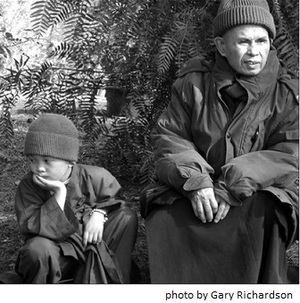
We all Carry Buddhas Within
You know that the human body is made of cells, and now science has declared that cloning is possible. From one cell they can duplicate the whole body. How is it possible? Because one cell contains the totality of the genetic heritage of that person. If not, how could we, from one cell, bring the whole body into full manifestation? So current science has proved not only in theory but in practice that, in the one you touch the all.
And we all have all our ancestors fully present in every one of our cells. We carry all of them while we walk, while we eat, while we do things. Without visualization you cannot see it. That is the power of the sixth consciousness, called the gardener.
Who is Mahamaya, the mother of the Buddha? Is that someone outside of you? Or is she you? Because all of us carry in our womb a Buddha. Mahamaya is very careful because she knows that she carries a Buddha within. Everything she eats, everything she drinks, everything she does, every film she watches––she knows that it will have an effect on her child. The Buddha Shakyamuni said, “You are a Buddha. There is a baby Buddha in each of you. Whether you are a lady or a gentleman, you carry within yourself a Buddha.” We also carry a Buddha but we are not as careful as Mahamaya in our way of eating, drinking, smoking, worrying, projecting and so on. We are not responsible mothers of the Buddha.
Like Mahamaya, there is plenty of room inside of us, not only for one Buddha but for countless Buddhas. We can declare, like Mahamaya, that we were the mother of all Buddhas in the past. We can be the mother of all Buddhas in the present. And we shall be able to be the mother of all Buddhas in the future. Mahamaya is hope. Is she outside in objective reality or is she inside ourselves?
So if you visualize like that, all negative feelings, all complexes will vanish. All doubt that you can behave with the responsibility of a Buddha’s mother will disappear and the Buddha in you will have a chance to manifest for yourself and for the world. And that is why visualization is a very important tool of meditation, of transformation. With a mind that is polluted by greed, by anger, you cannot do it well; that is why the purification of our thinking, of our mind, is very important. The practice of the Mindfulness Trainings, the practice of mindfulness of walking and sitting, the practice of samadhi to help purify the mind and to bring the fire of concentration to burn away the ignorance, the delusion. Through these practices, we erase all the wrong perceptions in us so that reality can reveal itself very clearly to us.
When mind has become true mind, when mind has become beautified in true mind, the world parakalpita is no longer there. Instead, the world parinispanna reveals itself completely. There is no longer any fear, any craving, any sorrow, any anger, because all these have been created by our wrong perceptions and our complexes.
Transcribed by Greg Sever; edited by Barbara Casey.
To request permission to reprint this article, either online or in print, contact the Mindfulness Bell at editor@mindfulnessbell.org.


